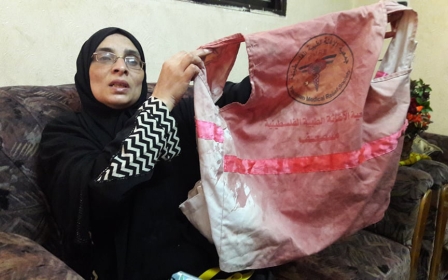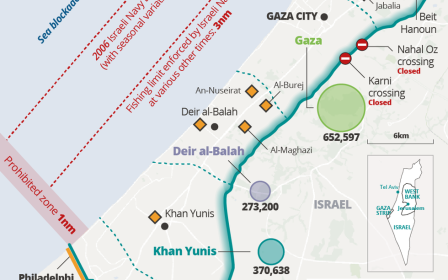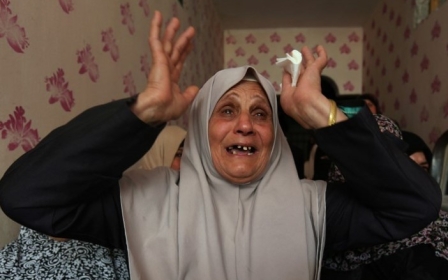How Israel upholds ‘security’ of apartheid

Three thousand, seven hundred and four. That's how many live ammunition gunshot injuries were inflicted by Israeli snipers on Palestinian demonstrators inside the Gaza Strip over a seven-week period beginning on 30 March. 3,704. In addition to 130 Palestinians killed during the same time frame.
One million, three hundred thousand. That’s how many bullets were fired by Israeli soldiers in the occupied Palestinian territory during the first few days of the Second Intifada. 1.3 million.
"The intent," wrote one Israeli journalist, "was to score a winning blow against the Palestinians, and especially against their consciousness. This was not a war on terror, but on the Palestinian people."
The ‘Palestinian threat’
In 2002, then-Israeli army chief Moshe Yaalon said that victory meant "the very deep internalisation by the Palestinians that terrorism and violence will not defeat us... If that [lesson] is not burned into the Palestinian and Arab consciousness, there will be no end to their demands of us."
In the same interview, Yaalon described the "Palestinian threat" as akin to "cancer" – and said the army was "applying chemotherapy" in the towns and cities of the West Bank and Gaza.
The goal was simple: crush Palestinian resistance. It is the same goal that motivates the Shin Bet officer facing a Palestinian youth handcuffed to an interrogation table
The response by Israeli authorities to Gaza’s Great Return March – one of massive, devastating violence – cannot be understood in isolation.
The mobilisation of battalions and special forces, the open-fire regulations, and the thousands of bullets fired, are not explainable as a response to some unique threat. Even talk of “disproportionate force” lacks the clarity needed to grasp what took place and is taking place.
The casualties that overwhelmed hospitals and operating theatres were not a consequence of “mistakes”. Lethal violence was a deliberate choice by the most senior Israeli officials.
The goal was simple: crush Palestinian resistance. It is the same goal that motivates the Shin Bet officer facing a Palestinian youth handcuffed to an interrogation table. It is the same goal that Israeli officials have in mind when weighing up how many travel permits to allocate – and to whom.
Politically motivated blockade
Two thousand, two hundred and seventy-nine: that’s the number of daily calories Israeli officials calculated that each Palestinian in the Gaza Strip requires to keep them from malnutrition, even as a politically motivated blockade has destroyed the territory’s economy.
"Israeli officials have confirmed... on multiple occasions that they intend to keep the Gazan economy on the brink of collapse without quite pushing it over the edge," noted a 2008 US diplomatic cable.
The total number of Palestinians shot and injured by Israeli soldiers using live ammunition in 2017 was 801, including 176 children, according to a UN Office for the Coordination of Humanitarian Affairs source.
Recall the video published last month by B’Tselem, showing three Israeli soldiers discussing who, and how, to shoot, during a demonstration by Palestinian residents of Madama village, near Nablus. Earlier that day, the villagers had attempted to remove a roadblock thrown up by the soldiers.
"Wait for them to come nearer," one said. "As soon as they realise that the stones don’t reach, they’ll be frustrated... they’ll come a bit closer," he added. "We need one good hit, and that’s it. That’ll teach them not to throw stones." Colonial armies are always keen teachers.
Mass incarceration
Five hundred and fifty-one: that's the number of Palestinians detained by Israeli occupation forces in the month of April, snatched on the street or taken from their homes. Many are tortured and interrogated without a lawyer, processed and convicted through military courts.
There are currently more than 6,000 Palestinian prisoners in Israeli jails, including more than 400 jailed without charge or trial – so-called administrative detention. It is not uncommon for Palestinians serving such a detention order to reach their release date, only to be served with a new order.
Mass incarceration, like the use of well-protected snipers against demonstrators, like the bullets fired at Palestinians defending their homes and communities during arrest raids, is not about “security” – at least not in the sense that Israeli officials use the term, ad nauseam.
Rather, what is at stake is the “security” of the occupation, the stability and longevity of a system of oppression, the maintenance of the status quo. This is the overriding goal to which, over the decades, Israeli political, military and intelligence officials have dedicated themselves.
The science of military rule
Sometimes, crushing Palestinian resistance requires bullets. But there are many stages before you reach the soldier squeezing the trigger. It’s a real science, military rule – after all, occupying a people against its will, year after year, denying them self-determination and liberty, is no easy task.
Permits and checkpoints, carrots and sticks. Ramadan "gestures" and collective punishment. Detention without trial and "confession" sheets in Hebrew. Home demolitions and industrial zones. The last resort, however, is always the gun. After all, the "security" of apartheid is at stake.
- Ben White is the author of Israeli Apartheid: A Beginner's Guide and Palestinians in Israel: Segregation, Discrimination and Democracy. He is a writer for Middle East Monitor and his articles have been published by Al Jazeera, al-Araby, Huffington Post, the Electronic Intifada, the Guardian's Comment is Free and more.
The views expressed in this article belong to the author and do not necessarily reflect the editorial policy of Middle East Eye.
Photo: Israeli soldiers talk during clashes with Palestinian protesters in the village of Kafr Qaddum, near Nablus in the occupied West Bank, on 1 June 2018 (AFP)
New MEE newsletter: Jerusalem Dispatch
Sign up to get the latest insights and analysis on Israel-Palestine, alongside Turkey Unpacked and other MEE newsletters
Middle East Eye delivers independent and unrivalled coverage and analysis of the Middle East, North Africa and beyond. To learn more about republishing this content and the associated fees, please fill out this form. More about MEE can be found here.






